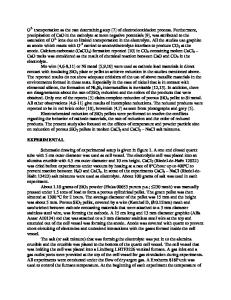Experimental and Modeling Study on Reduction of Hematite Pellets by Hydrogen Gas
- PDF / 2,114,055 Bytes
- 9 Pages / 593.972 x 792 pts Page_size
- 75 Downloads / 332 Views
UCTION
THE rising interests in application of direct-reduced iron (DRI) have given the researchers new challenges in this area. An important factor in production of DRI in industrial practice, such as MIDREX or HYL processes, is the dynamic control of the process in the reactors. This dynamic control along with optimization of the process is essential to ensure both smooth process operation and the quality of the products, for example the metallization degree and cementite fraction in the reduced pellets. In the counter-current reactors for direct reduction, the oxide pellets move downward from the top of the reactor facing the gas mixture injected from the lower part. The chemical potentials of the gaseous species and the temperature vary at different positions in the reactor. The chemical potentials of the species can also differ inside each pellet at a given position. Hence, an efficient dynamic control of the process and the quality of the products demands a realistic process model. A number of modeling works can be found for reduction of single pellets through different mechanisms, and for multi-particle reduction processes.[1–16] In a work by Bonalde et al., reduction kinetics of iron ore pellets were described by the grain model.[1] Pure H2, pure CO, and gas mixtures similar to MIDREX gas were used. Reduction by pure gases was controlled by a MANIA KAZEMI, MOHSEN SAFFARI POUR, and DU SICHEN are with the Department of Materials Science and Engineering, Royal Institute of Technology, 10044 Stockholm, Sweden. Contact e-mail: [email protected] Manuscript submitted June 27, 2016. METALLURGICAL AND MATERIALS TRANSACTIONS B
mixed mechanism in the initial stages and was changed to diffusion controlled mechanism at later stages. When the gas mixtures were applied, reduction was controlled by a mixed mechanism during the whole process. The model considered the size of the particles and the porosity of pellets and the results were in good agreement with experimental data for reduction by H2. Tien and Turkdogan developed a mathematical model for the isothermal reduction of single iron oxide pellets by a single-phase reducing gas (H2 or CO).[2] They developed a two-zone and a three-zone model for pellets with different diameters. It was demonstrated that the three-zone model consisting of a metal layer, metaloxide layer, and oxide core could describe the reduction of pellets used in direct reduction process. Kinetic models for gaseous reduction of single pellets with shrinking core or grain model have also been studied by other researchers.[3–6] The reduction zone of the shaft furnace in MIDREX process was simulated by Parisi and Laborde.[7] The unreacted shrinking core model was applied to the pellets. The process model developed assuming plug flow in the reactor was validated by data from two industrial plants and was found useful to predict the effects of different operation conditions on the process. Ranzani da Costa et al. simulated the reduction in a shaft furnace using hydrogen as the reductant.[8] They developed and validated
Data Loading...











